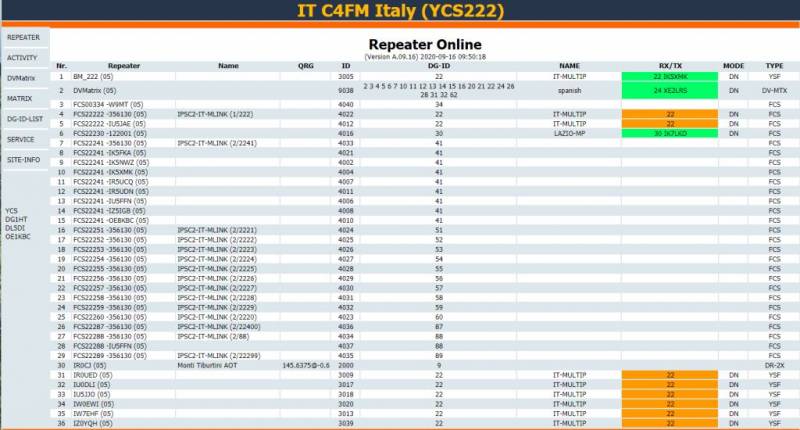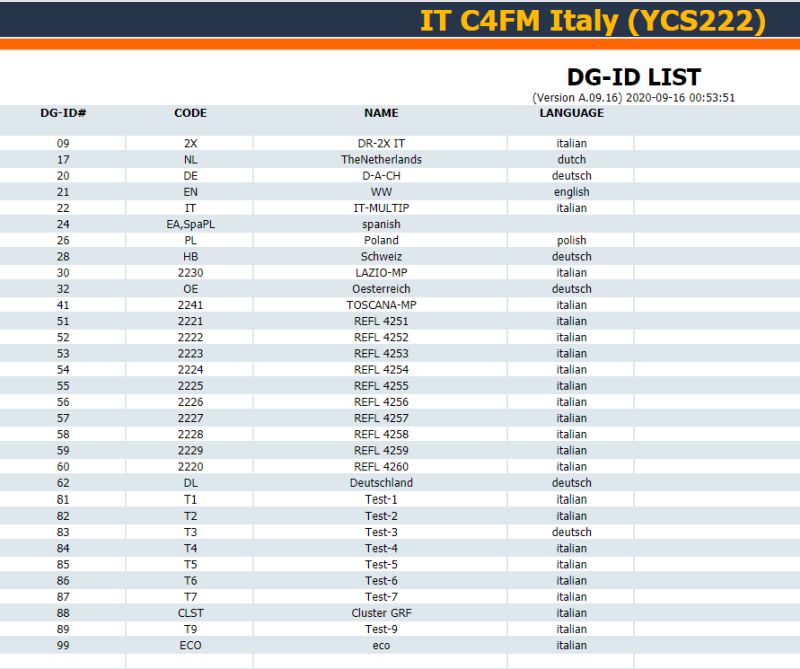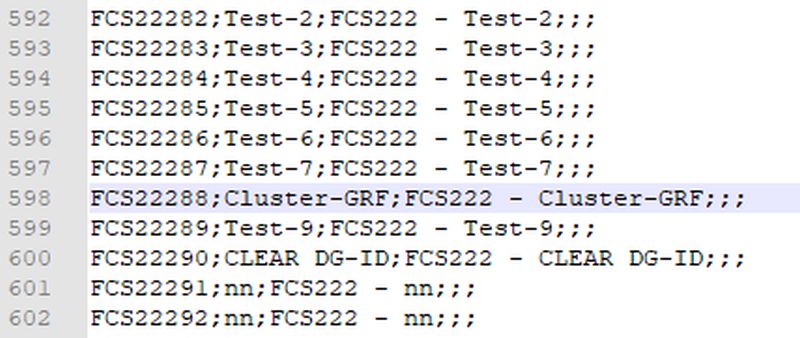User Tools
Table of Contents
YCS Server Overview
New features have been implemented on the YCS servers
a solution for connecting repeater bridges and hotspots using the C4FM / Yaesu Fusion 2 amateur radio digital protocol with excellent operational quality and customized configurations. It is a project developed by Kurt OE1KBC.
In Italy the reference server is YCS222 and is interconnected with the BrandMeister 2222 network and the DMRPlus networkfor a complete and widespread presence on the territory. This C4FM reflector is available to all amateur radio colleagues and allows you to simplify connection management through a single and practical dashboard. Furthermore, if someone wants to do without managing their own YSF reflector, they can now easily rely on this system to continue normal operation with the new resources available.
The YCS world reflectors are interconnected, so it is easily possible to make foreign QSOs as is already the case for the DMR and DSTAR world. Let's see in detail the operating procedures.
The operational dashboard of YCS222
- REPEATER : connected repeaters and hotspots.
- DVMatrix : Here you can see DG-ID groups being passed to other YCS servers (similar to interlinks with DMR and D-STAR).
- ACTIVITY : last stations listened to
- DG-ID : the available DG-ID groups. The X indicates that the corresponding DG-ID group is permanently connected to the respective repeater / hotspot.
- DG-ID-LIST : list of DG-ID groups with their descriptions.
- GROUP : the “Group” column shows the fixed DG-ID groups (a kind of Talkgroup statically in the DMR world).
- RX / TX : QSOs in progress are displayed in green (origin) and orange (destination) . After a transmission there is 30 second protection (displayed in blue) against raid so that the repeater / hotspot continues to receive on the previously used DG-ID group and not on another DG-ID.
- MODE : DN / VW mode. Please ALWAYS use DN on your radio at this time.
- DG-ID : name of the DG-ID group.
- TYPE : System (protocol) with which the repeater / hotspot is connected: DR-2X / IMRS, YSF, FCS
- DG-ID numbers with yellow background : DG-ID numbers that can be manually selected (on demand) but cannot be activated permanently. Duration of the request: 10 minutes. It can be deactivated instantly by sending the TX DG-ID 90 (NINE ZERO)
Who can we QSO with on YCS222 All digital amateur radio systems are very dynamic, this means that changes and new implementations and interconnections can be present frequently . To see “who we can talk to” you need to see the
Matrix section
To give some examples, the connection in YSF mode (ID DTMF # 22201) is combined with Group 22 (DG-ID 22) which corresponds to Italy. BrandMeister Italia is connected to this Group (through TG 22292 MULTIPROTOCOLLO ITALIA) and TG 222 of the Italian DMR + network ( IPSC2-IT-MLINK and IPSC2-IT-RPTR servers ). A great opportunity to do QSO !! Let's not forget also the HBLink.BrandMeister open-source system always connected to this Group and to the XLX DStar reflectors . Another example: if I want to speak with the Lazio multi-protocol, I have Group 30 ( DG-ID 30 corresponding to TG 2230) available , forTuscany Group 41 (DG-ID 41 corresponding to TG 2241 ) is always multi-protocol . Other interconnections can be requested by writing to info@grupporadiofirenze.net or to the managers of the servers indicated.
And if we want to talk to foreign countries (eg Spain) in C4FM? By simply selecting the relevant Group (DG-ID), as shown in the matrix displayed on the worldwide collector / server that collects the flows of all WW systems. The affected Group must be present on the source and destination servers.
Each server, in its DG-ID LIST section, shows the active and usable Groups:
and, in the Interlink section, the list of connections (TG) with the DMR world through the IPSC2 servers:
How to connect to YCS222
YAESU FUSION 2 repeaters connect directly to the server through their software, set DG-ID 01 as base (unassigned). Communicate the repeater information to the reflector manager so that information such as frequency, location, etc. is displayed in the dashboard. Using the Pi-Star software, for MMDVM systems (repeaters and hotspots) select the connection from the drop-down menu of the available C4FM rooms, for example, FCS222-41 to connect YCS222 and Group 41 . See below the connection to Tuscany multiprotocol in FCS mode :
At the time of writing this article, the “official” Pi-Star does not allow the sending of DG-IDs (digital tones) received by Yaesu devices . Pending this next implementation, the connection to Group 22 (Italy) is provided by default in YSF mode. Therefore on any C4FM / YSF MMDVM repeater or hotspot it is possible to send DTMF tones # 22201 (after activating the Wires-X connection to the system - see the manual of your device -, the repeater responds “connected”) and we will be connected to YCS222 Group 22. Otherwise it is always possible to select the “room” from the drop-down menu of the Pi-Star:
We can however switch from one Group to another in YSF mode through the DTMF tones typed on the radio / microphone instead of the DG-ID. To do this we need to create a kind of table of DTMF tones that correspond to the groups present on YCS222. We open the file “/usr/local/etc/FCSHosts.txt” of our Pi-Star and copy the contents into a Notepad program that shows the line number. Let's make the first row containing an FCS be number 10, as shown:
at this point the line number of the file coincides with the code to be selected (in the example sending the DTMF tones # 00598 will connect Group 88 on YCS222):
So with the “standard” Pi-Star it is possible to connect to any FCS / DG-ID Group as long as you use the code of the line number of the FCSHosts file (if at the first attempt it does not connect, just insist)












